

Sustainable living is all about living in a way that doesn't damage the environment. This means using renewable energy sources, recycling, and waste reduction, and using natural resources more efficiently. It's a way of living that's better for both the planet and its inhabitants.
There are many reasons why sustainable living is important. First and foremost, it can help reduce greenhouse gas emissions and slow down climate change. It can also help preserve natural resources, conserve energy, and reduce pollution. Sustainable living is also good for our health and well-being, as it can lead to a more active lifestyle and contact with nature.
10 Tips For A More Sustainable Life
Dial down your heat or A/C when you're away
Adjusting your thermostat 7 to 10 degrees for 8 hours each day will yield up to a 10% savings on your annual energy bill and help decrease your carbon footprint. You can even add insulated window curtains to block drafts in the winter and sunlight in the summer.
Switch to rechargeable batteries
Are you still using old-fashioned, single-use, alkaline batteries in devices like your TV's remote control? Try rechargeable batteries instead. You'll save money over time and help cut down on the billions of dollars worth of batteries sold each year in the United States, most of which never see a recycling facility.
Dine in instead of eating out
Most of the energy used by the average restaurant goes toward things like sanitation, refrigeration, and lighting, while only 35% goes toward preparing your meal. You can easily reduce your carbon footprint — and save a bit of money — by eating at home instead.
Sip smarter with a reusable coffee cup
More than 50 billion coffee cups are trashed each year. Due to their polyethylene linings, most are unrecyclable. The next time you head to the coffee shop, bring a reusable cup.
Bike to work
Consider biking to work at least one day each week. You'll cut your emissions for the week by a minimum of 20%.
Create a plastic-free bathroom
Try to make your bathroom a plastic-free zone. Buy bar soap and shampoo; get a bamboo toothbrush, and switch to toothpaste tablets instead of tough-to-recycle tubes.
Use reusable metal straws
The next time you order a drink, ask for no straw or bring your own metal straw. Plastic straws are one of the number one items found in oceans.
Avoid single-use items
Avoid single-use items that are made from plastic: coffee pods, to-go utensils, disposable razors, etc. The items and their packaging end up in landfills and in the ocean, threatening marine life. Reduce the amount of trash you produce by buying items in bulk.
Use washcloths instead of paper towels
Instead of single-use, disposable paper towels and napkins, try making your own reusable, washable cloth. Buy fabric in bulk and cut it into squares, or repurpose some of your old t-shirts or towels. You'll save trees and help reduce the billions of pounds of non-recyclable paper that end up in our landfills annually.
Go digital
Use an e-signature company like Docusign, Congasign or scan and email documents, to avoid unnecessary printing.
As the effects of climate change become more and more evident, it's clear that we need to do something to protect our planet. And sustainable living is one of the best ways to do that.

ABOUT THE AUTHOR
Hey, guys! It's Brianna, the Content Specialist at Compass. Find me here on LinkedIn and we'll connect!




